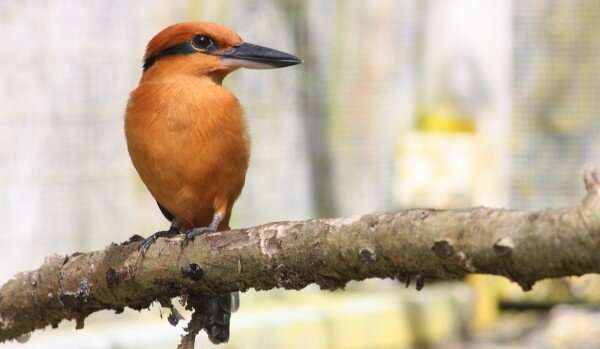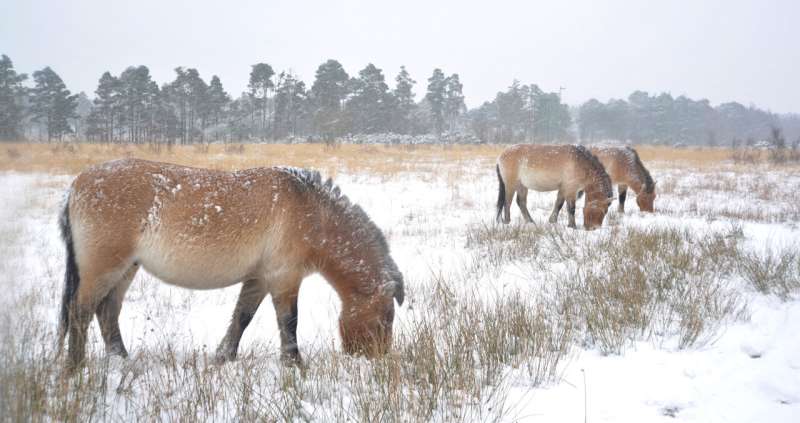This article has been reviewed according to Science X's editorial process and policies. Editors have highlighted the following attributes while ensuring the content's credibility:
fact-checked
peer-reviewed publication
trusted source
proofread
Science can prevent extinctions for species on the brink of death

New research examining the perilous state of dying species calls for urgent international conservation efforts to develop unified management plans that could help plants and animals return from the brink of extinction.
The study, published in Science, found species categorized as extinct in the wild (EW)—populations solely found outside their natural habitat, such as in captivity—could have their declines prevented and reversed with urgent international effort.
Species include the Sihek (Guam kingfisher), the ʻalalā (Hawaiian crow) and Partula snails from the South Pacific; and in Australia, the Christmas Island blue-tailed skink and Lister's gecko.
"The loss of these species can have a ripple effect on entire ecosystems, and if we don't take urgent action, the consequences could be catastrophic," Dr. Carolyn Hogg, co-author of the study, said.
Dr. Hogg is part of the University of Sydney's School of Life and Environmental Sciences and co-leads the Australasian Wildlife Genomics Group. She is also a member of a global task force of the International Union for Conservation of Nature (IUCN), whose mission is to develop methods to boost the profile of EW species.
Dr. Hogg and colleagues examined 84 EW species on the 2022 IUCN Red List, 72 of which remain in the category while four have become extinct. A further 21 EW species dating back to 1950 have had their status change—12 have been returned to nature, but nine have gone extinct.

In one Australian example, changing habitat and introduced species triggered a decline in native lizards on Christmas Island in the 1970s, with two species rescued into human care in 2009.
The Christmas Island blue-tailed skink is a small lizard known for its striking iridescent blue tail, which was once found all over the island. Their reintroduction if it continues to be successful could benefit other species by showing the benefits of introducing species outside their range to maintain species in the wild. This is particularly important for species that will be impacted by climate change where their current range may not exist in the future.Christmas Island blue-tailed skink (Cryptoblepharus egeriae)
Starting with just 66 founding individuals, it has been successfully released to the wild on the Cocos islands where its population has now reached 1,100.
Another compelling example of bringing a species back from the brink is the rewilding of the scimitar-horned oryx, where the last wild remaining population was brought into captivity in the 1960s and was successfully reintroduced into Chad in 2016.
"The current rate of species loss is unprecedented in human history and is largely due to human activities," Dr. Hogg said. "This study highlights the need for the conservation and academic communities to better apply research findings into practice to maximize the survival rate of individuals when released back into the wild."
One of the major conservation challenges highlighted in the paper is the small number of individual plants and animals remaining for EW species, which places them at risk of extinction. The quantity of most EW species sits well below the minimum threshold required to guarantee a viable population for their long-term survival.

To capture the genetic diversity of a wild population, between 30 and 50 founding individuals are recommended for a population in human care—at the minimum. But most populations of EW species have been founded by fewer than 30 individuals, with some plant species growing from just a single individual.
Higher levels of genetic diversity can help increase resilience against disease or environmental threats and reduce the risk of extinction.
"The smaller a population becomes, the faster it loses genetic diversity and inbreeding increases, leading to a reduction in reproduction and other fitness," Dr. Hogg said. "This is problematic for the long-term survival of the species."
Another challenge facing EW species is preferential treatment. While attempts have been made to return most animal species to the wild, most plants have been neglected.
Dr. Sarah Dalrymple, at Liverpool John Moores University in the UK and study co-author, said, "There are several reasons why extinct in the wild plant species might be less frequently the focus of translocations, including a lack of suitable individuals for planting and changes to their original habitat."
"However, attitudes are shifting, with more emphasis on botanic gardens working together and finding suitable wild homes away from the site of origin, offering great hope for future plant recovery."
The researchers emphasized the danger posed by a wave of extinctions over the coming decades. They warn the number of EW species might be increasing, but without a sound way of tracking them we will not know until it's too late.
The process of recording a plant or animal's absence in their natural habitat has a median lag of 11 years from the time they disappear.
Dr. John Ewen, senior author of the research from the Zoological Society of London, said, "We have the ability to protect and save all of these species, but successful recoveries are made easier when we have more individuals in breeding programs and a faster turnaround between loss from the wild and their return to it."
The IUCN World Conservation Congress has called for today's EW species to be returned to the wild by 2030.
Charting the return of extinct in the wild species
A second paper, published last week in Diversity co-authored by Dr. Hogg, charts a path back for EW species, presenting five possible scenarios for halting their decline.
The scenarios cover the challenges facing EW species and establish practical conservation action for each situation.
More information: Donal Smith, Extinct in the wild: the precarious state of Earth's most threatened group of species, Science (2023). DOI: 10.1126/science.add2889. www.science.org/doi/10.1126/science.add2889
Sarah E. Dalrymple et al, Addressing Threats and Ecosystem Intactness to Enable Action for Extinct in the Wild Species, Diversity (2023). DOI: 10.3390/d15020268
Journal information: Science
Provided by University of Sydney

















